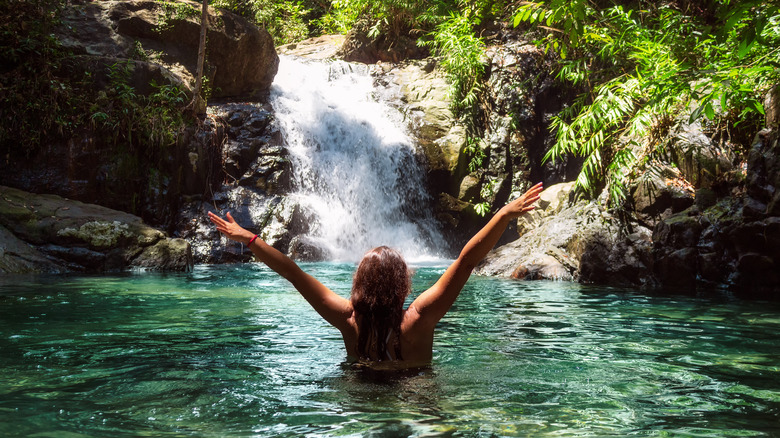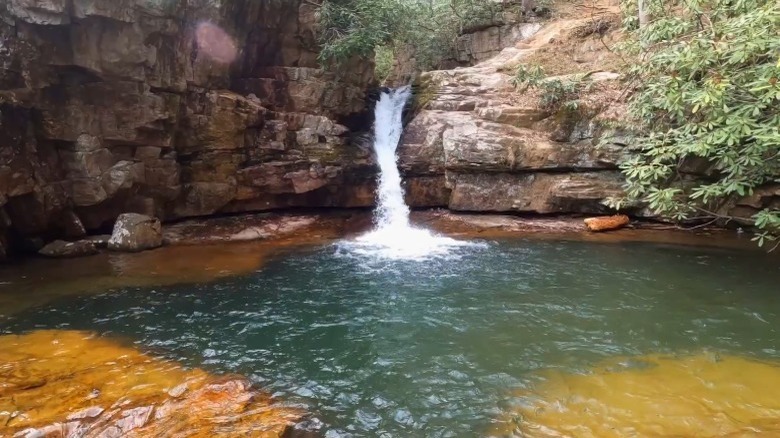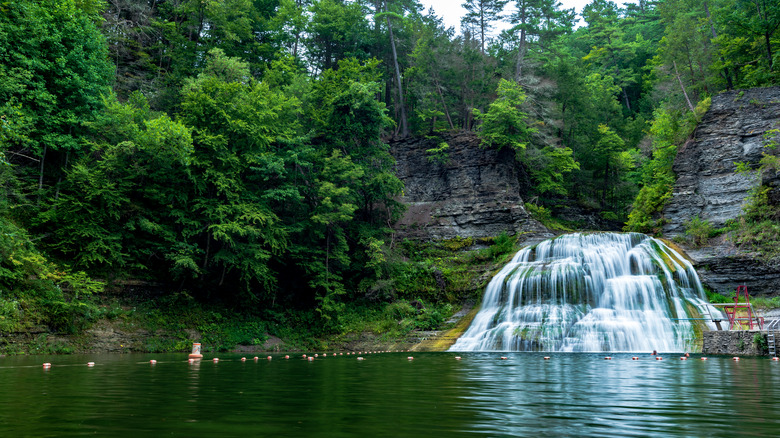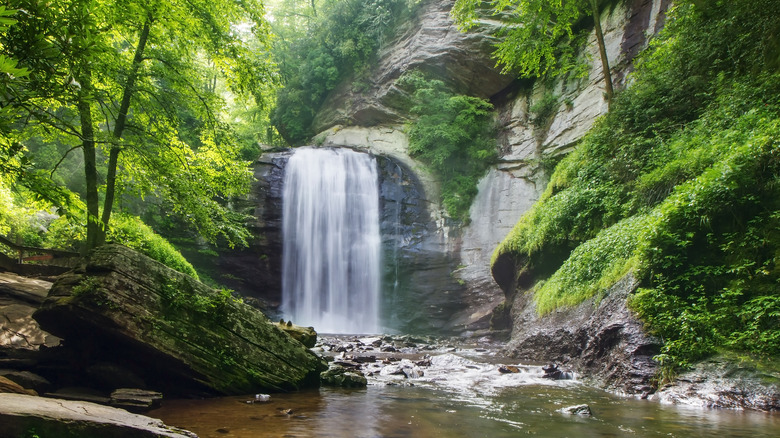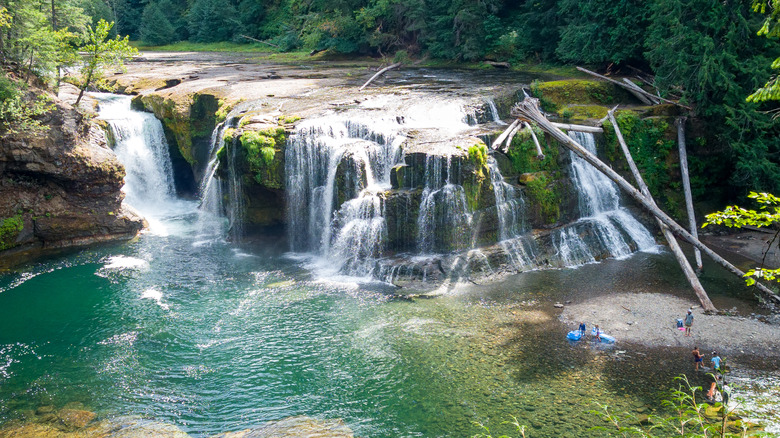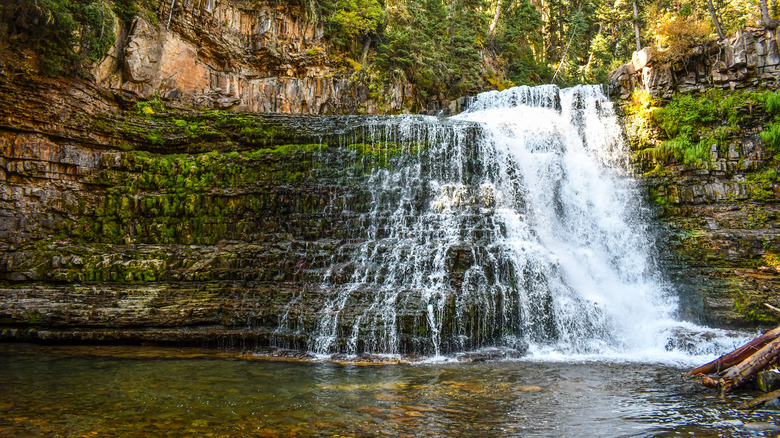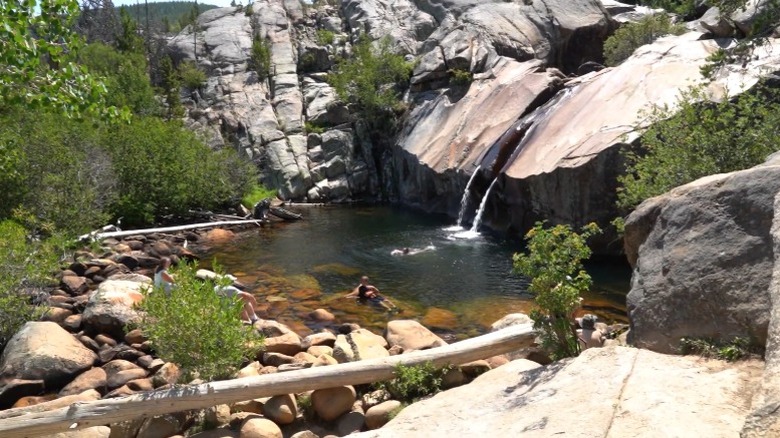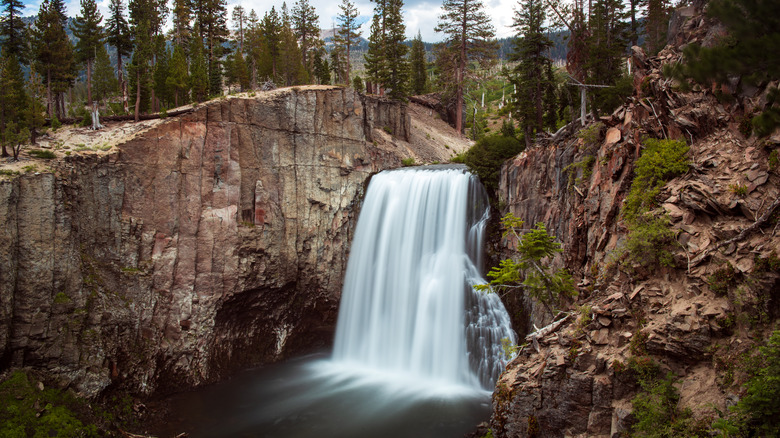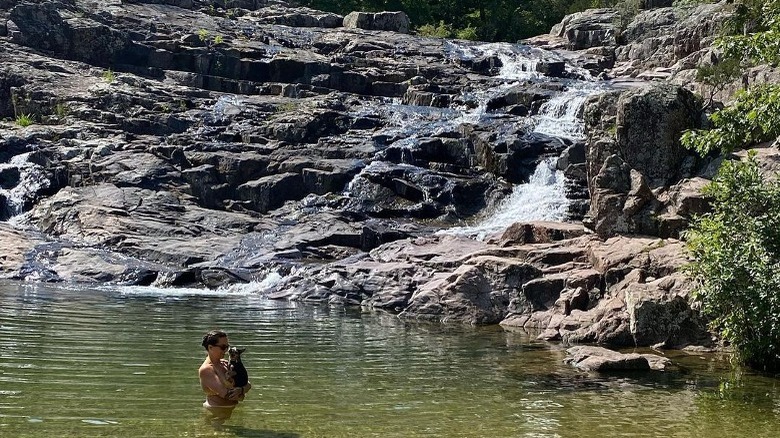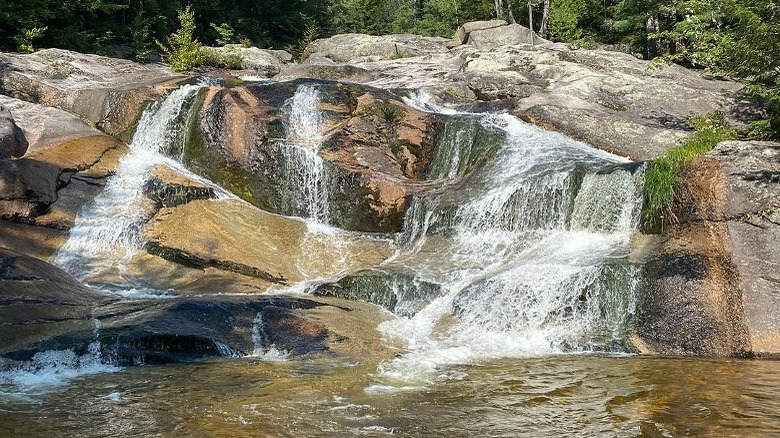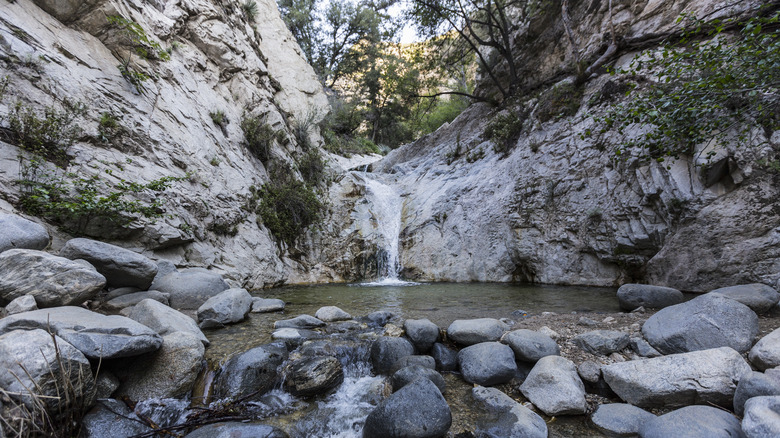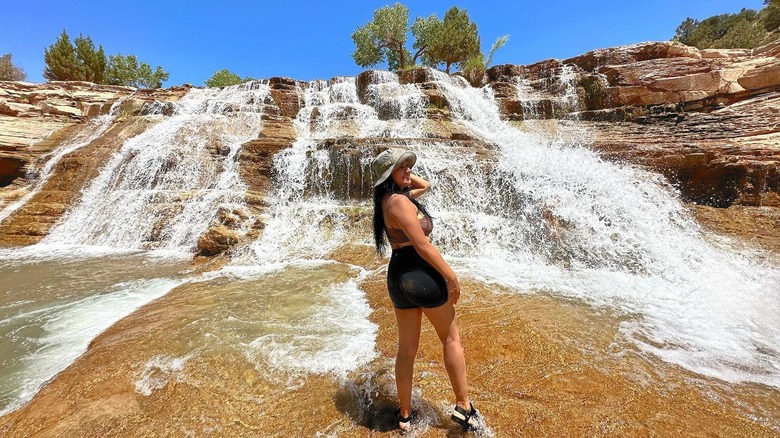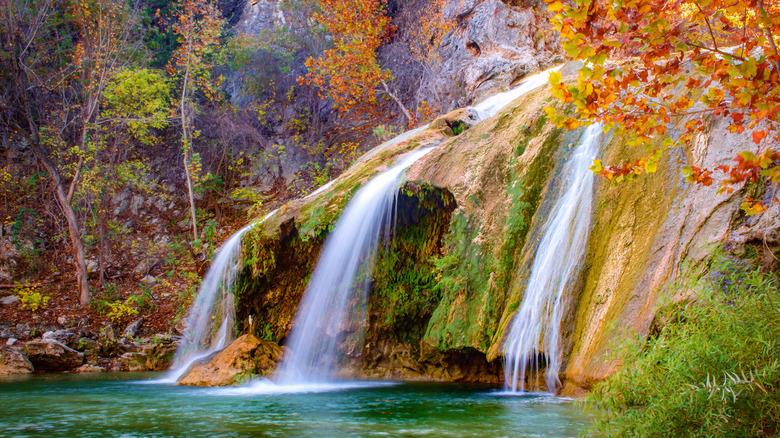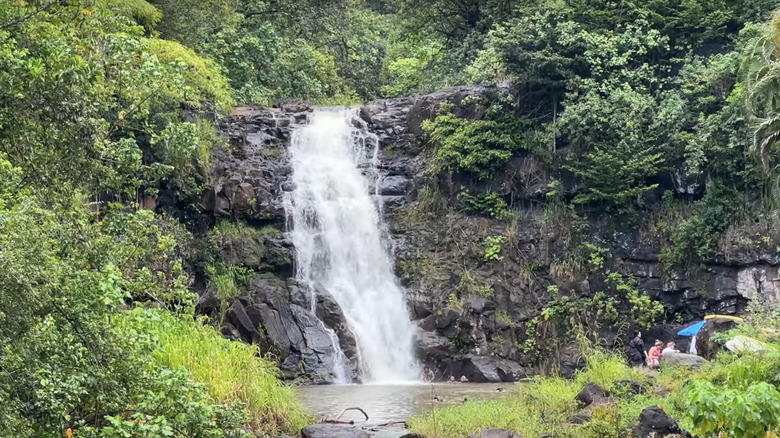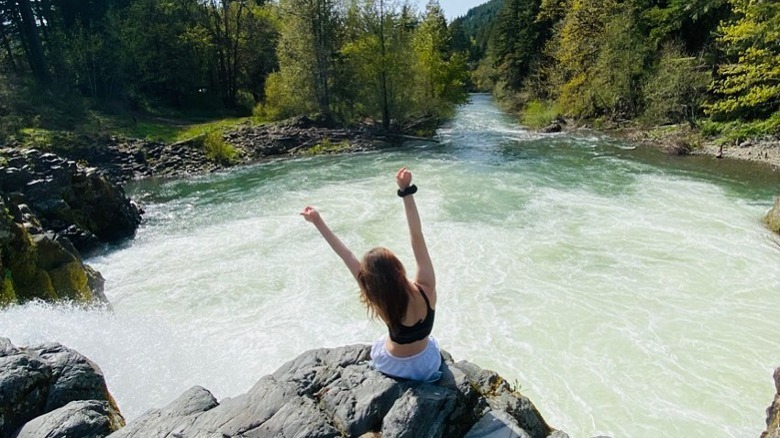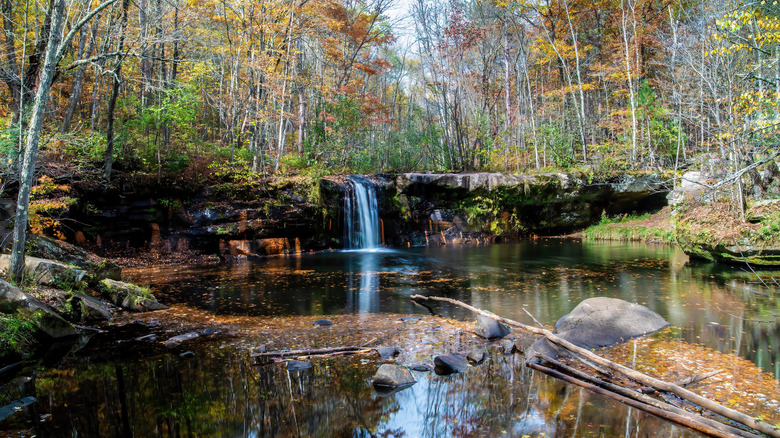You Can Swim In These Downright Gorgeous Waterfalls In The US
The United States boasts no shortage of waterfalls — more than 17,000 by some estimates — with some of them globally renowned. Travelers from all over the planet descend on the northwest corner of New York state to marvel at Niagara Falls, while hikers can enjoy the sheer drop of Bridalveil Fall in Yosemite National Park. Waterfalls are enjoyable to admire, and their murmuring and rumbling sounds are pleasingly soothing, but to fully appreciate a waterfall's inspiring power, you need to sit under it.
Feeling the pressure of the rapids descending, the water cascading upon you with all its force, is both energizing and humbling. It's also therapeutic, a form of natural massage as the endless streams push and knead your knots. Not all waterfalls around the country provide conditions where it's permitted, or safe, to swim under them, but the ones listed here do. Not only are they perfect for some underwater splashing, but they're also pretty to look at, whether from a distance or up close. For a once-in-a-lifetime travel experience, dust off the trunks and get ready for some waterfall swimming.
Blue Hole Falls, Tennessee
Accessed from a loop trail that should take less than 15 minutes, this waterfall near Elizabethton gets its name from the hypnotic blue water in the pool below the cascade. This isn't a wildly developed site with a large parking lot and oodles of signposts, but the trailhead leads off a dirt parking area, and the spaces fill up quickly in the summer. The hike to the falls winds down the side of a hill, with trees flanking the trail and fallen leaves cushioning each footstep. The sound of the rumbling water is a precursor to seeing the falls.
The water drops from a small channel between high rock faces, emptying into a pool of brilliant blue water — to really appreciate the colors, come on a sunny day. The water is not only gorgeously hypnotic, it's also exceptionally clear, especially in the shallower parts of the swimming hole. Even non-swimmers will appreciate the scenery, with plenty of rock perches around the falls and pool from which to admire the natural splendor.
Enfield Falls, New York
For bathers that prefer the added blanket of security that a lifeguard provides, swimming under waterfalls in a state park is a wise choice. Also known as the Lower Falls, this natural attraction is situated in the Robert Treman State Park, a destination with more than 10 waterfalls peppered across its expanse. Enfield Creek is the waterway that winds its way through the Enfield Glen, with passages of gorges and layered, moss-covered rock faces that climb up high.
The falls are broad and bulbous, almost like the top of a mushroom that seems to be emitting water from its apex, and swimmers can get under the falls or use a diving board to plunge into the pool. It's easy to get to Enfield Falls, with a short paved walkway leading to it and steps that ensure easy entry into the swimming area. The park is beautiful and located in one of the most pretty parts of New York state — the Finger Lakes region.
Looking Glass Waterfall, North Carolina
Southwest of Asheville and in the Pisgah National Forest, these inviting, wood-enshrouded falls are a big draw in the long, hot days of summer. The ease of access is one reason for the generous numbers that visit, as the parking lot close to the falls makes getting to them a breeze. But the real draw is the chance to swim in the cooling waters. The cascade's name derives from the Looking Glass Rock, a giant boulder peak not far from the waterfall.
The waterfall itself might not be as grand as the rock, but it's bewitching all the same, a broad screen of water dropping more than 50 feet into a shallow pool. There are many places to get soaked, from right under the falls to the large swimming hole where water flows through and on the rocks of the smaller rapids below. The falls are also attractive in the winter, when ice forms around them, giving them an ethereal beauty. The water freezes in the winter, turning it into a reflective mirror when the sunlight strikes it.
Lower Lewis River Falls, Washington
Within the Gifford Pinchot National Forest, in the south of Washington, the Lower Lewis River Falls is one of a trio that hikers usually include as part of a multi-hour trek. It is, however, the only one where visitors can take a dip without having to put in a lengthy slog on the trails. It is located in a remote forest with cedar and fir trees, as well as plenty of moss, and the healthy branch cover makes the hike a relatively shady outing. Be aware that this is quite a remote part of Washington state, and cell service can be patchy.
The lower falls are near the Lower Falls Campground, a less than 15-minute walk away. The falls drape over various sections of rock, offering multiple spots where visitors can soak, and the swimming pool at the bottom is roomy. Some choose to dip in the river at the top of the falls or the streams that run over the rocks before the drop, while daredevils will leap from the top into the swimming hole below. This water is cold, so plan to jump in when the sun shines directly overhead — the rays will help you warm up when you exit.
Ousel Falls, Montana
Hikers in Big Sky Country don't have to walk far to get to this waterfall. The route to the cascade involves a trail that skirts the South and West forks of the Gallatin River and requires that travelers cross over a series of bridges en route. The trail is well-maintained, paved, and easy to navigate, with smaller cascades to see on the way. There are several options for getting to the falls, depending on which part you plan to visit.
A couple of routes take visitors to overlooks, with one heading to the top of the falls. The fourth option heads to the bottom of the waterfall, where a swimming hole is fed by the roaring cascade, and there is an area primed for picnics. Head to the overlooks first to get a sense of the delicate beauty of the falls and trace the way that the water travels down a series of small, stepped rock faces before emptying into the pool at the base.
Popo Agie Falls, Wyoming
Thrillseekers looking for more bang for their buck should seriously consider a trip to these falls located in the heart of Wyoming. It's a place where travelers can sit under the water and feel the relief as it pulses on them, or, for more fun, they can slide down the rocks of the waterfall before dropping into the pool below. Getting to the falls entails a 1.5-mile hike, part of it along a fork of the Popo Agie River, with wildflowers adding some color to the scenery.
The falls are a great place to picnic while looking at large, serious clumps of rock where water skids down before bubbling into a small watering hole. On a hot day, easing into the pool is such a treat, but a better way for some instant cooling is to head to the top of the falls and find the smoothed line of rock to the left. Get in position and slide down. You'll splash straight into ice-cold water, but the shock and sense of relief will immediately banish any heat you've generated on the hike.
Rainbow Falls, California
Devils Postpile National Monument is a haunting, wondrous sight. Tall columns of almost perfectly carved basalt rise 60 feet like they were carefully positioned as part of a giant installation or a natural sculpture. But the destination is also incredibly appealing for the Rainbow Falls, a pair of cascades that are an easy walk downhill from the trailhead. Close to Mammoth Mountain, a popular skiing spot in the winter, the falls are reached via trails that wind through fir and pine forests. The upper falls are more striking, dropping more than 100 feet, with rainbows often forming when the sun shines. The flow is immensely powerful.
For fans of getting wet under waterfalls, the lower falls will be more of a draw. There is a spacious water hole under the lower falls, a place to dip your feet or plunge in to really cool off before wading over to bathe under the rapids. The waterfall journeys through some granite piles into the pool and is a little slice of paradise on a searing hot summer day.
Rocky Falls, Missouri
Volcanic rock forms the foundation of this swimming hole and waterfall in the Ozark Mountains. The cascades unravel over a series of terraces, creating a visually engaging landscape, like a water garden designed on the grounds of a stately home, while the trees behind add some color to the scene. The waters, fed by springs, have slowly eroded channels and chutes in the rock face, so in addition to creating waterways for the cascades, there are sections of the falls where visitors can slide down to drop into the swimming hole below.
While the swimming section is large and deep with beautifully clear water, it's not the only area for a cooling dip. There are tranquil pools and tame channels at the top of the falls that are equally rewarding spots for lounging. Visitors can also sit in the many streams that wind their way down the red-tinged rock face.
Step Falls, Maine
In the west of Maine, not far from the border with Vermont, Step Falls is a gradual cascade featuring multiple swimming holes, some small enough only to fit a couple of swimmers, others more roomy and perfect for a family splashing vacation. As the name suggests, the falls are a series of drops and cascades located within the Step Falls Preserve and close to Grafton Notch State Park. Step Falls is fed by water from a mountain stream that gradually courses through blocks of granite. In the spring, the flow can be powerful, thundering as it descends on its path, carving out small channels and streams en route.
The falls are certainly a fetching sight, but the pools are even more hypnotic, calling out for visitors to plop into them. The largest pool, large enough to house a church choir or two, is fed by small waterfalls. After a refreshing dip, travelers can find a quiet spot on the slabs of rock and enjoy a relaxing picnic soundtracked by the dulcet harmonies of rushing water.
Switzer Falls, California
Streams, mountaintops, shaded trails, and canyons all come into view on the hike to Switzer Falls, located about 30 minutes north of Pasadena. There are actually a pair of cascades here; the upper one is taller but only has a little space to swim underneath, while the lower falls are the ones that really grab your attention. The lower falls almost look like they were designed with some splashing in mind, with water that drops about 20 feet into a pool cupped by a semi-circle of vertical rock.
Some small boulders enclose the pool and add some cool grays to the scene. The pool is about stomach deep, perfect for cooling off after the hike, which is short enough that wading over to the falls isn't challenging or tiring. The walk to the falls and back on the Gabrielino Trail features a descent to the falls before the uphill return trek and extends about 5 miles in total.
Toquerville Falls, Utah
You'll need a keen sense of adventure — and a sturdy vehicle — to reach these gorgeous falls that showcase the stunning red rock of Utah. Located in the south of the Beehive State, Toquerville Falls is accessed via an unpaved road, rough and bumpy, peppered with steep drops and climbs and hefty rocks. A four-wheel drive vehicle is essential, preferably one with a high clearance. You'll need to navigate 5 miles of this terrain at slow speeds, but the payoff is sublime.
Here, two sets of falls drop into wading pools. The upper pool is relatively shallow and ideal for youngsters, while the lower one is deeper, but there are also little pools dotted around the place where water creates small bowls. The effects of erosion by the water are plain to see, making for a truly magnificent sight. Overhangs on the rock allow visitors to get shade while in the water or find a spot to leap into the swimming hole. The rocks are terraced, like steps, so visitors can easily find a ledge to sit on and let the water wash over them. This place will place you in its hypnotic spell.
Turner Falls, Oklahoma
The seductive-sounding Honey Creek feeds Turner Falls, the largest in Oklahoma state. Turner Falls sizes up at almost 80 feet, a surging torrent of water that branches around a craggy knuckle of rock to create a few different drops. It sits within Turner Falls Park, a 1,500-acre site with a castle, walking trails, plenty of greenery, and wildlife, including deer and wild turkeys. There are also caves in the park, where amateur and expert geologists can pore over different rock formations composed of limestone, shale, sandstone, and granite.
Turner Falls pour into a large swimming hole, one that's calm and clear, with water that has a hypnotic baby blue color that looks almost like it's been lifted from a beach in the Caribbean. During the summer, crowds will frolic in the shallows, wade over to the falls, and swimmers will dunk their heads under the curtains of water.
Waimea Falls, Hawaii
It's a relatively easy 30-minute hike to get to this waterfall on the north shore of Oahu. Situated in the Waimea Valley, the Waimea Falls is a cascade with a sheer 40-foot drop over cliffs, collapsing into a vast, deep swimming area. In addition to swimming under the falls, travelers — both locals and tourists — come here to stand-up paddleboard, kayak, and snorkel. Snorkeling in Hawaii is a truly incredible experience.
The Hawaiian name of these falls, which is also a deeply revered site for indigenous people, depends on the strength of its flow. When flowing lightly, it's called Waihe'e, or softly dripping water, while stronger flow gives it the name Waihi, or purging water. Wai, or freshwater, holds great significance in the Hawaiian culture, seen as a force central to life. The Waimea Valley is also home to many cultural sites, including centuries-old places of worship, stone shrines dedicated to the fishing god Ku'ula, traditional Hawaiian buildings made from wood and coconut fiber that were the homes of chiefs, and a burial site.
Wildwood Falls, Oregon
Less than an hour southeast of Eugene, Wildwood Falls aren't the kind that will have you craning your neck up to see the top, but the way they are formed is something quite miraculous. A broad upper pool bleeds out and cuts several snaking routes through the top of a basalt cliff before the water drops 15 feet into another generously proportioned expanse of water. The pool below is one of the finest in Oregon, a deep body of water that locals will frequently leap into from the cliff tops above, either close to the falls or around the sides.
The cliffs are, as expected, craggy and knobbly, and visitors would be wise to wear water shoes when traversing them. Also known as the Row River Falls, there's no easy route to the bottom except to take a leap, and the way back up involves scrambling up the rock face.
Wolf Creek Falls, Minnesota
Around 100 miles due north of Minneapolis, Banning State Park is a slice of nature that offers visitors a range of activities. Explorers can canoe on the Kettle River, kayak along sections of rapids, stretch their legs on hikes around the woods, spend nights under clear skies at the campground, and wander around old buildings on a former quarry. They can also hike to Wolf Creek Falls, a short waterfall where a thick curtain of water drops into a grand swimming area.
While it's not a huge waterfall, its hidden setting makes it feel special. At Wolf Creek Falls, when the trees all around are ablaze in color, the scene feels like it's been lifted from the promotional brochure of a tourism board. While swimming under the falls is easy enough and heaps of fun, the more adventurous traveler might relish the prospect of standing right by the edge of the top of the falls and feeling the surging water rush over their feet.
